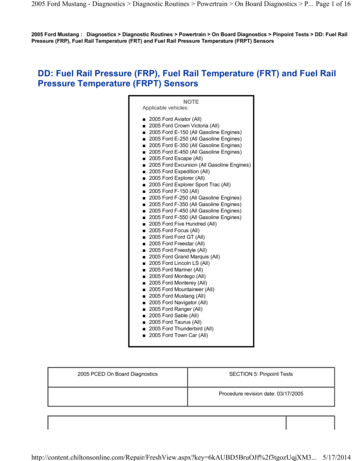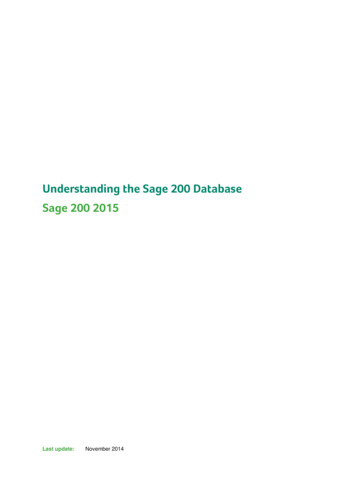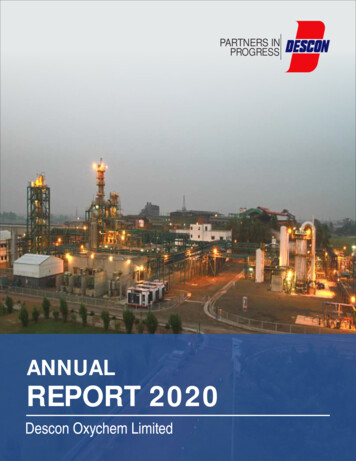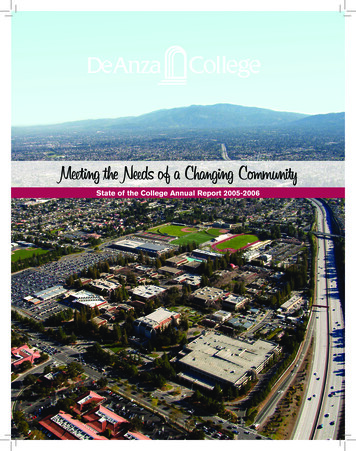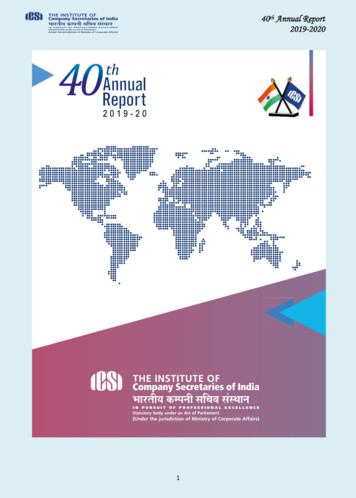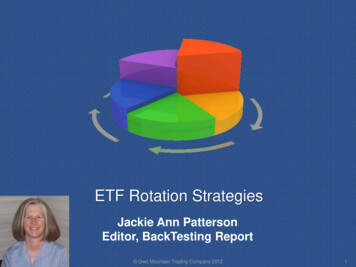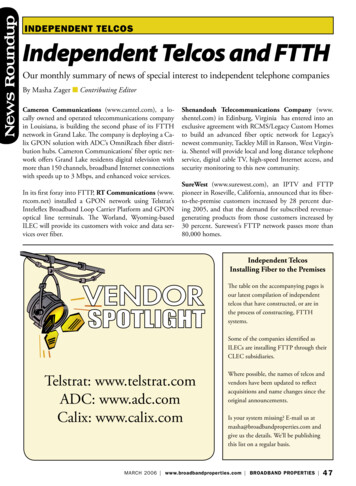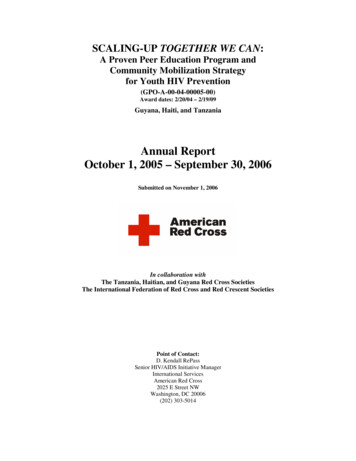
Transcription
SCALING-UP TOGETHER WE CAN:A Proven Peer Education Program andCommunity Mobilization Strategyfor Youth HIV Prevention(GPO-A-00-04-00005-00)Award dates: 2/20/04 – 2/19/09Guyana, Haiti, and TanzaniaAnnual ReportOctober 1, 2005 – September 30, 2006Submitted on November 1, 2006In collaboration withThe Tanzania, Haitian, and Guyana Red Cross SocietiesThe International Federation of Red Cross and Red Crescent SocietiesPoint of Contact:D. Kendall RePassSenior HIV/AIDS Initiative ManagerInternational ServicesAmerican Red Cross2025 E Street NWWashington, DC 20006(202) 303-5014
TABLE OF CONTENTSLIST OF ACRONYMS AND ABBREVIATIONS .3I.PROGRAM OVERVIEW .4A.B.C.D.INTRODUCTION .4EMERGENCY PLAN INDICATORS TABLE: FY06 TWC ANNUAL RESULTS .5EMERGENCY PLAN INDICATORS TABLE: TWC LIFE OF AWARD RESULTS .5PROJECT OVERVIEW AND PROGRESS TO DATE .6II.GUYANA PROGRESS REPORT .12III.HAITI PROGRESS REPORT.16IV.TANZANIA PROGRESS REPORT .21
LIST OF ACRONYMS AND ABBREVIATIONSARCThe American Red CrossARVsAntiretroviralsCARANCaribbean Red Cross AIDS NetworkCCMsCountry Coordinating MechanismsCCCommunity Council (local coordinating body for the project)CSMCommunity and Social MobilizationFederationInternational Federation of Red Cross and Red Crescent SocietiesFMField ManagerGRCSGuyana Red Cross SocietyHRCSHaitian Red Cross SocietyIFRCInternational Federation of Red Cross and Red Crescent SocietiesIRIntermediate ResultITsInstructor TrainersMTsMaster TrainersNRCSNational Red Cross SocietyODOrganizational DevelopmentPEsPeer EducatorsPLWHAPeople Living with HIV/AIDSSOStrategic ObjectiveTRCSTanzania Red Cross SocietyTWC“Together We Can”TWC Workshops PE led workshops based on the 12 hour TWC curriculumUNAIDSJoint United Nations Program on HIV/AIDSYMYouth Multiplier (youth participants in PE led TWC workshops)YPYouth Participant (youth beneficiaries reached by YMs via TWCtake-home assignments [peer to peer outreach] and/or via communitymobilization/ edutainment events)American Red CrossScaling-Up Together We Can3
I.PROGRAM OVERVIEWA. INTRODUCTIONThe Scaling-Up Together We Can (TWC) project (GPO-A-00-04-00005-00) is a 5 year, 7million abstinence and be faithful program that will reach 766,000 in and out-of-school youthages 10-24 with curriculum, peer to peer, edutainment and mass media based HIV preventionmessages in the countries of Guyana, Haiti and Tanzania. The program’s primary recipient, theAmerican Red Cross, is responsible for providing funding and technical assistance to theproject’s implementers--the Guyana, Haitian and Tanzania Red Cross Societies.Peer education, community and social mobilization, and capacity building for the three nationalRed Cross societies are the primary TWC project strategies used to promote positive behaviorchange among youth. The peer education component of the project is based on the 12 hour, 17activity Together We Can curriculum that has been used by the American Red Cross and theInternational Federation of Red Cross and Red Crescent Societies with over twenty Red CrossSocieties in the Caribbean, Central America and Africa since 1993. The curriculum usesdynamic, participatory techniques to improve youth’s knowledge, attitudes and skills relating toHIV/AIDS. The prevention messaging emphasizes abstinence (including secondary abstinence),being faithful to one’s partner, and other healthy behaviors including condom use for at-riskyouth. Abstinence is the key message for all age groups.In addition to working directly with youth, TWC creates an enabling environment for youthbehavior change by actively seeking the participation of parents, teachers, religious leaders, hostcountry government officials, NGO staff and other community leaders. In this manner, theAmerican Red Cross and its sister Red Cross societies in Guyana, Haiti and Tanzania capitalizeon the synergy of working at the both the individual and community level, assuring a holistic,grassroots response to the HIV pandemic.Another critical strategy--improving the national Red Cross societies’ ability to manage andexpand youth HIV prevention projects—is accomplished through formal trainings, individualcoaching, systems development, and the dissemination of best practices. Focus areas include:curriculum adaptation, volunteer management, community mobilization techniques, andestablishing accurate and agile management information systems.This report was prepared by the American Red Cross in tandem with its sister Red CrossSocieties in Guyana, Haiti and Tanzania. These National Red Cross Societies are run and staffedby citizens of these three respective countries. They are sovereign, nationally recognized entitieswith extensive grassroots volunteer bases and possess intimate knowledge and longstandingexperience in responding to public health emergencies in their local communities.American Red CrossScaling-Up Together We Can4
B.Emergency Plan Indicators Table: FY06 TWC Annual Results(October 2005 - September 2006)GuyanaHaitiTanzaniaProject TotalPlannedTargetActual% of TargetMetPlannedTargetActual% of TargetMetPlannedTargetActual% of TargetMetPlannedTargetActual% of r of female youth (10-24) 38%86,750 119,356138%Number of male youth (10-24) reachedTotal number of youth (10-24) 43190,304162%154%50,000 72,689100,000 141,693145%142%86,750 126,814173,500 246,170146%142%IndicatorPrevention/Abstinence and Be FaithfulCommunity OutreachTotal number of individuals trainedC.Emergency Plan Indicators Table: TWC Life of Award Results(February 2004 - September 2006)GuyanaHaitiTanzaniaProject TotalPlannedTargetActual% of TargetMetPlannedTargetActual% of TargetMetPlannedTargetActual% of TargetMetPlannedTargetActual% of %Number of female youth (10-24) reached33,00024,89175%125,000 85,30168%225,000 117,38952%383,000 227,58159%Number of male youth (10-24) reachedTotal number of youth (10-24) reached33,00066,00020,51845,40962%69%125,000 86,283250,000 171,58469%69%225,000 121,052450,000 238,44154%53%383,000 227,853766,000 455,43459%59%IndicatorPrevention/Abstinence and Be FaithfulCommunity OutreachTotal number of individuals trained
D. PROJECT OVERVIEW AND PROGRESS TO DATEStrategic Objectives, Key Approaches and ActivitiesIn order to achieve its goal of reducing the incidence of HIV among youth, the TWC projecthas three primary strategic objectives.Strategic Objective 1The first objective is to strengthen HIV related life skills for 10-24 year old youth. This isaccomplished through setting up viable and well managed peer education structures through therecruitment and training of field managers (instructor and master trainers) who in turn train andsupervise peer educators. Youth reached by the project benefit from the following outreachstrategies:Curriculum based interventions via 12 hour, 17 activity TWC workshopsThe highly participatory workshops are designed to help youth avoid HIV infection by providingthem with knowledge and skills so they are empowered to make informed and healthy choicesconcerning their sexual behavior. Each workshop is facilitated by a pair of peer educators forapproximately 20 youth and generally takes one month to complete.Peer to peer outreachPeer Educators ask each participant in TWC workshops to share HIV prevention messages with10 of their peers as ‘take-home assignments’. This outreach strategy is referred to as the‘multiplier effect’ due to the vast networking power of using youth as a vehicle for transmittingkey behavior change messages to their siblings, schoolmates and friends. In this manner, youthattending TWC workshops are not passive learners, but are directly implicated in HIV preventionin their communities.Edutainment events. Edutainment events (also referred to as community mobilization events)include concerts, street theater, film viewings, and sports events. They are designed todisseminate vital prevention and solidarity messages to larger groups of youth ranging fromseveral dozen to several thousand per event. When edutainment events are held in schools andproject sites where numerous TWC workshops have already been held, this method allows forcontinued post-curriculum follow-up and message reinforcement.Youth clubs: Existing youth clubs, often school based, are targeted for specific interventionssuch as role plays and film viewings. Since many of the club members have already benefitedfrom TWC workshops, this method allows for continued post-curriculum follow-up and messagereinforcement.Mass Media. The project primarily uses radio shows and PSAs to share TWC messages withthe majority of youth living in target areas. With primary emphasis placed on interpersonalcommunication (curriculum based interventions and peer to peer outreach), less than 1% ofproject funds are spent on mass media programming and diffusion. In Tanzania, the projectreceives donated air time, lowering costs even further.
Strategic objective 2 focuses on strengthening each National Red Cross Society’s capacity tomanage and expand youth HIV prevention projects. This is accomplished internally throughorganizational development trainings offered by American Red Cross staff and other NGOpartners. Training topics include volunteer supervision, project planning, finance andcompliance, monitoring and evaluation and curriculum adaptation. Externally, capacity is builtby encouraging partnership building with other NGOs and national youth HIV preventiontaskforces. These partnerships allow the National Red Cross Societies to learn from andleverage each partner’s expertise in the domain of HIV prevention, care and treatment. Commongoals, strategies and messages are established and duplication of efforts is reduced, leading to amore efficient and rational use of project resources. Lastly, in attempts to identify anddisseminate best practices, exchange workshops are held between Red Cross branches within thesame country and between Red Cross societies and Red Cross Movement partners at the regionallevel.TWC’s third strategic objective is to enhance the community environment for the adoptionof safer sexual practices. Community is defined here as adult stakeholders who influencedirectly or indirectly the environment in which youth make safe or unsafe sexual decisions.These adult stakeholders include parents and teachers as well as religious and secular communityleaders from the public, non-governmental, informal and private sectors. The TWC projectinforms, seeks permission to operate, and solicits direct involvement of adult communitymembers in the fight against HIV/AIDS and in the safer reproductive lives of youth through theorganization of town hall meetings. These meetings are held in schools, churches and towncenters. TWC National Red Cross Society staff invite core groups of adults attending town hallmeetings who are already members of existing community councils (such as parent teacherassociations and local AIDS taskforces) to become involved in day to day projectimplementation. Examples of direct community council engagement include help in planningTWC workshops in schools, consensus building on appropriate messaging for younger youthages 10-14, in-kind contributions to project activities, promoting TWC sessions via letters toparents, and offering feedback after observing project activities.Key AccomplishmentsAs the Emergency Plan Indicators Table demonstrates, the Together We Can project hasexceeded its annual objective of youth reached by over 140%. TWC also surpassed its trainingobjectives for FY06 with 251 new field managers and peer educators joining the project. Overthe life of the award, over 455,000 youth have benefited from TWC outreach interventionsrepresenting 59% of TWC’s five year life of project target goal. As TWC is exactly at itshalfway point, this figure demonstrates that the project is slightly ahead of schedule in itsperformance in numbers of youth reached. In order to minimize double counting issues, thesefigures represent a 50% reduction in youth reached by edutainment and peer to peer outreach inTanzania. Double counting among TWC’s three main outreach interventions is mostpronounced in rural areas where high numbers of youth are being reached. Currently thesefactors most apply to the Tanzania portion of the program.Over the life of the award, the program has trained only 26% of anticipated peer educators andfield managers per life of project goals stated in the original project proposal, representing half ofAmerican Red CrossScaling-Up Together We Can7
the number expected at this juncture in the project. These lower numbers of individuals trainedreflect a deliberate strategy since mid 2004 to achieve high retention rates for volunteers andfield staff. The project believes that more experienced staff and volunteers will deliver betterprogramming and therefore increase the likelihood of positive behavioral impact with youthbeneficiaries. Project annual workplans such as the one for FY06 incorporate this strategy ofquality over quantity in numbers of individuals trained to implement TWC’s peer educationsystem.The vast majority of youth reached through TWC sessions in Guyana and Haiti were in-schoolyouth. Tanzania has the largest number of out-of-school youth completing TWC sessions withapproximately half of their youth multipliers in this category. All three National Red CrossSocieties conducted interventions for high risk groups this reporting period including armedforces in Guyana, orphans in Haiti, and orphans, handicapped children and blind youth inTanzania.All six new project expansion sites listed in the FY06 Workplan were opened during orimmediately prior to the current reporting period. The expansion process included recruiting andtraining field managers and peer educators for each new area. All of the newly opened branchesoffered the full mix of outreach interventions to youth beneficiaries with the exception of Region1 in Guyana and Fort Liberté and Anse-a-Pitre in Haiti. TWC workshops were not held in FY06in these latter three sites.The American Red Cross facilitated four workshops, all held during the months of February andMarch. Haitian, Tanzanian, and Nigerian1 Red Cross youth peer education project managerstogether with a representative of the IFRC attended TWC’s first ever exchange workshop. Heldin Tanzania, the ten day workshop covered a mix of presentations and direct observation ofactivities covering the following themes: best practices in youth peer education, curriculumadaptation, working with 10-14 year olds, peer educator incentives, supervision processes, M&E,community and project planning mapping and working with adult stakeholders. Some of themost useful aspects of the exchange workshop were building a sense of community amongproject staff in different regions and comparing technical strengths and weakness through arigorous peer review process. The Haiti project team benefited in particular from observing theTanzanian Red Cross Society’s more established PE supervision and adult stakeholdermethodologies.In March, a Haitian curriculum specialist engaged as a consultant for the HRCS presented herfindings as part of TWC’s curriculum review and adaptation workshop. Participants includedseveral key representatives of the IFRC, Haitian MOH, Netherlands Red Cross and the Presidentof the Haitian Red Cross. The findings, covering all aspects of the curriculum from age andcultural appropriateness, clarity of instructions, comprehension and participation levels andaccuracy, were based on an extensive series of focus groups held in three project sites withbeneficiaries, peer educators, field managers and project coordinators. All three donors—theARC, IFRC and Netherlands Red Cross—agreed to retain the consultant so that she can, basedon her recommendations, revise the curriculum and pilot the new version. Once completed, thisnew curriculum will improve upon the TWC methodology and implementation in all countriescurrently using the curriculum which extend well beyond the three countries formally part of thisAmerican Red CrossScaling-Up Together We Can8
Emergency Plan cooperative agreement. A significant number of the consultant’srecommendations have already been incorporated into revised curriculum activities that arecurrently being used by Haitian peer educators with beneficiaries. Project coordinators trainedHaitian field managers on these new activities in June and they in turn trained peer educators onthe adaptations in the last quarter of the fiscal year.Rounding out the workshops for the period, ARC’s regional Finance and Admin Delegate andDeloit and Touche consultants lead a finance and compliance performance workshop for TRCSfinance and program staff in Dar-es-Salaam and Kigoma. Lastly, the American Red Crossengaged a respected security training firm to facilitate a security training for its Americas staffincluding TWC project managers based in Washington and local project staff in Haiti. Whilevery relevant to the TWC project in Haiti, this latter training was not funded by Emergency Planfunds.Reinforcing its collaborative relationship with the IFRC, TWC Guyana project managers, fieldmanagers and peer educators benefited from an inter-region lessons learned workshop led by twoexpert Federation trainers in March. The participants agreed that introducing the program to andtraining adult stakeholders in the basics of HIV transmission and prevention were critical to theprogram’s success and could be considered best practices. After a detailed review of thecurriculum, project staff made several revisions to activities enhancing cultural relevancy andentertainment value to increase participation levels and comprehension among youth reached.The IFRC trainers clarified the methodology behind several of the curriculum’s activities to fieldmanagers and peer educators, enhancing their capacity to facilitate future TWC sessions.In April, project coordinators and several field managers from the Guyana and Haitian Red Crosstogether with ARC project and technical managers attended IFRC’s 6th Bi-Annual CaribbeanRed Cross HIV/AIDS Network Meeting. Highlights of this meeting uniting all 16 CaribbeanRed Cross societies using TWC included presentations on IFRC’s new HIV/AIDS mass mediacampaign, explorations of how to reach most at-risk populations and trainings on TWCmanagement and M&E. ARC headquarters and field staff and the Tanzania Red Cross’ HealthDirector attended the 2006 International AIDS Conference (IAC) in Toronto where the HaitianRed Cross project coordinators presented a poster on their peer education work with youth in theslum area of Cité Soleil. The TWC Haiti team’s IAC presentation was filmed and diffused byCanadian and Haitian television.As part of the TWC project’s goal to engage the wider community in which we work, close to2,500 adult stakeholders including local government leaders, parents and teachers attended TWCtown hall meetings in Guyana, Haiti and Tanzania. Tanzania and Guyana had 27 activecommunity councils involved with the project during the fiscal year. The HRC linked its townhall meetings to the delivery of project equipment to intervention sites, reinforcing projecttransparency and community understanding of the TWC project.All three National Red Cross Societies have developed brochures to hand to youth participants tobetter guide and systematize the transfer of key messages during TWC sessions, peer to peeroutreach and edutainment events. Nevertheless, these materials need to be better pre-tested andfurther modified using a logic model in order to improve their efficacy as behavior changeAmerican Red CrossScaling-Up Together We Can9
materials. The American Red Cross will continue to provide support to the National Red CrossSocieties both in materials development and, where possible, adaptation and use of existing BCCmaterials designed by other NGOs working with youth.Major Issues/ConstraintsFlooding in Region 9, low numbers of youth reached by peer to peer outreach and the absence ofa lead field manager in Region 1 in Guyana contributed to the Guyana Red Cross falling just shyof reaching their goal of 15,000 youth reached during FY06. The American Red Cross also feelsthat more youth can be reached in the population dense area of Region 4 and is recommendingthat an assistant field manager be engaged by the GRC to ramp up outreach in the Georgetownarea.Record levels of kidnappings and civil unrest related to repeated postponements of presidentialelections created an extremely difficult working environment for Haiti project staff. Severalmeetings with ARC staff had to be held outside of Haiti as a result. The Haiti program has justbegun to conduct town hall meetings during the last quarter of the fiscal year and has yet to formcommunity councils with adult stakeholders. With the prolonged absence of local projectmanagers as well as technical staff from ARC regional and national headquarters, projectoversight in remoter and newer branches has suffered. With the currently improved securitysituation, site visits by ARC staff have increased and the Haiti TWC project managers haveresumed visits to project sites. Two project sites-- Fort Liberté and Anse-a-Pitre—were onlypartially active during this reporting period.As the Tanzanian Red Cross expands to ever more remote districts in the Kigoma region,attendance at some field manager-peer educator planning meetings has suffered due totransportation issues. Even with issued motorcycles, the supervision of peer educators by fieldmanagers has become more and more challenging. A fourth project vehicle will be orderedduring the next fiscal year to help address transportation issues.The TWC program continues to explore methodologies for identifying at-risk youth between theages of 10-14. Haiti and Tanzania have yet to reach the objective of 40% of youth beneficiariesfalling in this youngest age cohort. The Haitian Red Cross in particular has only reached some8,000 youth ages 10-14 during FY06. Approximately thirty percent of youth reached inTanzania are 10-14 years old. In order to best match the current curriculum with the cognitiveand physical development of early adolescents, the American Red Cross has recommendedincreasing the number of beneficiaries in the 10-14 year old age group with particular emphasison 12-14 year olds.In Haiti, only 647 out of a total of over 90,000 youth reached were out-of-school/at-risk, fallingwell short of the year’s objective of having 10% of youth fall in this category. Communitymapping of orphanages and restavec (marginalized domestic servants) has occurred and the HRCshould reach an increased number of at-risk youth in FY07.American Red CrossScaling-Up Together We Can10
The database for the entry and analysis of pre-post questionnaires by individual question andcomposite indicators, while near completion, was not finalized during FY06. It is hoped that thedatabase will be completed during the first quarter of FY07.Planned ActivitiesThe TWC project was evaluated in Haiti in May and in Tanzania in July by MEASUREEvaluation. The major goal of TWC during the next fiscal year is to implement the evaluation’srecommendations including finalizing curriculum adaptations and introducing targeted follow-upinterventions for youth multipliers to increase the likelihood of long-term positive behavioralimpact. A consultant has been hired to assist the American Red Cross and the National Societiesachieve these goals. In March 2007, TWC will hold its second Exchange Workshop in Haiti inorder to share best practices, disseminate key updates in the field of youth peer education andfacilitate dialogue between the three National Red Cross Societies implementing the project.1The American Red Cross managed a youth peer education program with the Nigerian Red Cross similar to the TWC project.American Red CrossScaling-Up Together We Can11
II.GUYANA PROGRESS REPORTFY06 Results for GuyanaOctober 05 - September 06SOKey Country Level Workplan FY06 IndicatorsNumber of age, gender and culturally appropriate adaptations to TWCcurriculumNumber of Field Managers (MT/IT) and Peer Educators trainedNumber of youth completing entire TWC curriculumSO1Number of youth reached by peer to peer outreachNumber of youth reached by community mobilization eventsTotal youth reached with community outreach programsNumber of youth reached by mass media programsNumber of operational partnershipsSO2 Number of operational national project task forcesNumber of staff trained in organizational developmentNumber of adults attending Town Hall meetingsSO3Number of operational community councilsPlannedTargetActual% 65%94%121%100%160%66%38%Key AccomplishmentsThe TWC Guyana project is operational in all three project sites—Regions 1, 4 and 9. Thirty-sixinstructor trainers and peer educators were trained during the reporting period, exceedingplanned objectives. Existing peer educators and field managers benefited from a series ofrefresher trainings held over the course of the fiscal year.The Guyana Red Cross did not meet its goals for youth reached through curriculum based andpeer to peer outreach interventions. The low number of youth benefiting from peer to peeroutreach is due in part to the remote nature of project sites in the Guyana hinterland. In isolatedboarding schools, youth beneficiaries are unable to interact with youth outside of their school,limiting the effectiveness of the youth multiplier effect. In total, over 14,000 youth were reachedthrough TWC’s three main outreach methods. Slightly more female youth were reached thanmale youth. Over 40% of youth fell in the 10-14 age bracket and under 20% in the 20-24 agecohort. The majority of beneficiaries were in-school youth, however the GRC did work with asmall number of high risk groups including police and military in Lethem, a number of whomwere referred to VCT and STI testing centers. Over 150 youth benefited from TWCinterventions to 6 youth clubs in Regions 4 and 9.Eight GRC staff received training in a variety of subjects including QuickBooks accountingsoftware, Epi-Info, M&E, project design and gender mainstreaming. The organizations offeringthese trainings ranged from the CDC, US Peace Corps, UNDP and IFRC/CARAN. The fieldmanager and assistant field manager in Lethem continue life skills and income generationtraining for their peer educators. Subjects include computer training and leather crafts, the latterdisplaying HIV prevention and anti-stigma messages.American Red CrossScaling-Up Together We Can12
In March, two IFRC expert trainers led an inter-region lessons learned workshop for TWCGuyana project managers, field managers and peer educators. The participants agreed thatintroducing the program to and training adult stakeholders in the basics of HIV transmission andprevention were critical to the program’s success and could be considered best practices. After adetailed review of the curriculum, project staff made several revisions to activities enhancingcultural relevancy and entertainment value to increase participation levels and comprehensionamong youth reached. The IFRC trainers clarified the methodology behind several of thecurriculum’s activities to field managers and peer educators, enhancing their capacity to facilitatefuture TWC sessions.Exceeding its objectives, the GRCS collaborated with 23 organizations including: the NationalBlood Transfusion Service, the Guyana HIV/AIDS Reduction and Prevention Project, CARAN,US PEPFAR cluster, the Rupununi Indigenous Development Association, the RupununiChamber of Commerce, CDC, Lethem AIDS Committee, Conservation International, CRS andthe US Peace Corps. Of these organizations, the first four are national or regional project taskforces. Of particular interest is the heightened collaboration between the GRC and the U.S.Peace Corps. Three Peace Corps Volunteers are working with the project on a regular basisassisting in trainings and other activities in Regions 4 and 9 with an additional Peace CorpsVolunteer providing occasional support in Region 1.TWC field managers and peer educators continue to build upon partnerships with communitybased organizations including Amerindian chiefs, local government leaders and parents andteachers. Field managers organized town hall meetings reaching 656 adult stakeholders andthree community councils were active in the day to day implementation of the project. The GRCcontinues to receive strong support from high level government officials including the governorsof Regions 1 and 9.Major Issues/ConstraintsThe Guyana Red Cross has been unable to fill the position of Field Manager for Region 1.Without clear leadership, Region 1 peer educators were only able to participate in a singleedutainment event benefiting 350 youth. Peer educators in this newly opened region did no
American Red Cross Scaling-Up Together We Can 4 I. PROGRAM OVERVIEW A. INTRODUCTION The Scaling-Up Together We Can (TWC) project (GPO-A-00-04-00005-00) is a 5 year, 7 . experience in responding to public health emergencies in their local communities. B. Emergency Plan Indicators Table: FY06 TWC Annual Results (October 2005 - September 2006)
